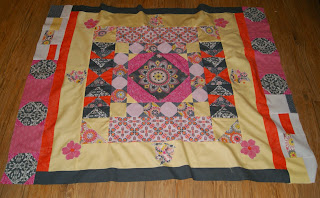A terrible, awful, very bad cold from my granddarlings.
I'm on the mend today (Saturday), but I have not felt well since Tuesday. Finally after gallons of chicken soup and tons of cold meds later, I am better. However, since my days this week consisted of just getting what work I needed to get done accomplished and face-planting into the bed, I haven't had time to take pictures and edit them. I really am disappointed because I finished two tops that I would really like to show you.
Hopefully next week....fingers crossed.
Instead I'd like to talk about your quilting footprint.
As quilters, we all know how important it is to document your quilt. Labels are extremely important.
None.
I purchased each of the quilts at consignment or thrift shops. Before I handed over the cash, I always asked about the history of the quilt. One of the ladies at one of the consignment shop even called the current owner for me and put me on the phone with him. Unfortunately, the only thing he remembered was that the quilt was made by a great-aunt from Northern Virginia and he couldn't even remember her full name. All that quilting history -- lost. It's just so sad. Quilters put so much energy and heart into their quilts and for years never considered what they did significant enough to document it in any way.
So please, on that label, put your full name, your location, who the quilt is meant for, the date, and pattern used. It will help so much in the future. If you don't believe me, Google your state's quilt documentation. Back in the 1970's and 1980's (and even beyond that in some states), groups of quilters got together with Quilt Symposiums and the National Associations and called for quilters and families to bring in their quilts. They did this in order to assemble a quilt history for each state. If you're into history, this is a fascinating study not only in quilts, but in textiles.
But boy, was it challenging. The internet was still in its infancy then, if it existed at all in some circumstances.
And that's what I want to discuss today. The internet. Like it, love it, or hate it, it's here to stay. All of us -- no matter how computer illiterate some folks are -- leave an electronic foot print. Whether it's medical records, email, or Facebook, electronically we will live forever in cyberspace.
Some people think this is not the best thing -- that some folks are too attached to their cell phones and Ipads and now their Apple Watch. Most days I honestly wish I could fling my cell phone off the highest cliff. But then again, I don't miss those days when I would come home from work and would spend a half an hour wading through phone messages on my answering machine before I started dinner. I figure that the internet is kind of like cable TV. I'm just old enough to remember when cable TV first came out and everyone it seemed condemned it. From pastors in the pulpit to the guy that delivered your newspaper, it seemed everyone thought it would be the end of family time and decency. I mean, you were going to be able to get those trashy movies that should be only shown at the theater beamed right into your den on your TV set!
Look how far we've come. We're able to get classic old movies, cooking shows, do-it-yourself TV, and even quilting shows. So cable wasn't all evil and neither is the internet.
As far as quilting goes, I believe that the internet is a quilter's greatest tool. Between YouTube and quilting forums, any question can be answered and pattern or fabric can be found. But it's also a great documentation tool. And that's what I would love for every quilter with internet access to begin to think about.
There's only so much information a quilter can put on a label, or your label gets to big. If you're putting your quilts on your Facebook page or a quilting forum, you can add so much more information. You can tell where the fabrics are purchased, how much you paid for them, how long each step took, why you chose the pattern and the colors, what the quilt means to you and why you decided to give it to a certain person.
So much -- so very, very much -- quilting documentation that can live on forever in cyberspace. Imagine what it would mean to your grandchildren and they're children if they can find your quilt on line in years to come and learn what that quilt meant to you.
What I wouldn't give if I could know these things about my great-grandmother's quilts.
We use the internet for everything else, from recipes to real estate purchases. There's no reason not to use it in quilt documentation. It's quick. It's easy. And it will last.
So have a Nike moment and just do it.











